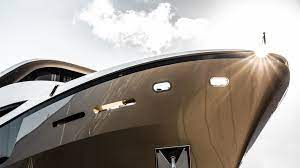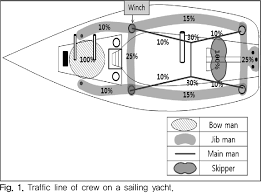The Importance of Ergonomics in Yacht Design: Making Yachts More Comfortable and Efficient
Ergonomics is the science of designing products, systems, and processes to optimize human well-being and performance. In yacht design, ergonomics plays a crucial role in making yachts more comfortable and efficient for passengers and crew. In this article, we explore the importance of ergonomics in yacht design and how it can improve the yachting experience.
The Benefits of Ergonomics in Yacht Design
Comfort: Ergonomic design can make yachts more comfortable for passengers and crew by reducing physical strain and discomfort.
Efficiency: Ergonomic design can improve the efficiency of yacht operations by reducing the time and effort required to perform tasks.
Safety: Ergonomic design can improve safety by reducing the risk of accidents and injuries caused by physical strain and discomfort.
Functionality: Ergonomic design can improve the functionality of yacht features and systems by making them more intuitive and easy to use.

The Key Principles of Ergonomic Design in Yacht Design
Human-Centred Design: Ergonomic design in yacht design should focus on the needs and preferences of passengers and crew, taking into account factors such as age, height, weight, and physical abilities.
Comfort: Ergonomic design in yacht design should prioritize comfort, by reducing physical strain and discomfort caused by long periods of sitting, standing, or performing tasks.
Accessibility: Ergonomic design in yacht design should prioritize accessibility, by making yacht features and systems easy to access and use for passengers and crew with varying physical abilities.
Efficiency: Ergonomic design in yacht design should prioritize efficiency, by reducing the time and effort required to perform tasks and operate yacht features and systems.
Examples of Ergonomic Design in Yacht Design
Seating: Yacht seating should be designed with comfort and ergonomics in mind, by providing appropriate lumbar support, adjustable headrests, and armrests.
Lighting: Yacht lighting should be designed to reduce eye strain and fatigue, by providing appropriate levels of brightness and color temperature.
Storage: Yacht storage should be designed to maximize accessibility and ease of use, by providing ample storage space and organizing it in a way that is intuitive and easy to navigate.
Controls: Yacht controls should be designed to reduce physical strain and effort, by providing intuitive and easy-to-use controls that are easy to reach and operate.
Challenges and Opportunities in Implementing Ergonomic Design in Yacht Design
Cost: Implementing ergonomic design in yacht design can be costly, as it may require the use of specialized materials and technology.
Integration: Ergonomic design in yacht design may require integration with existing yacht features and systems, which can be challenging and time-consuming.
Awareness: Not all yacht buyers may be aware of the importance of ergonomic design, which can make it challenging to prioritize it in yacht design.
Innovation: Ergonomic design in yacht design requires continuous innovation and adaptation to new technologies and materials.
Preparing for the Future of Ergonomic Design in Yacht Design
To successfully implement ergonomic design in yacht design, yacht designers and builders should take the following steps:
Research: Yacht designers and builders should research the latest trends and innovations in ergonomic design, to gain a better understanding of how it can be applied in yacht design.
Collaboration: Yacht designers and builders should collaborate with experts in ergonomics, such as ergonomists and physical therapists, to gain valuable expertise and guidance.
Prioritization: Yacht designers and builders should prioritize ergonomic design in the yacht design process, by taking into account the needs and preferences of passengers and crew.
Innovation: Yacht designers and builders should continuously innovate and adapt to new technologies and materials, to stay ahead of the curve in ergonomic design.
Conclusion
Ergonomic design plays a crucial role in making yachts more comfortable and efficient for passengers and crew. By prioritizing principles such as human-centered design, comfort, accessibility, and efficiency, yacht designers and builders can create yachts that provide a superior yachting experience. While implementing ergonomic design in yacht design can be challenging, it is an important investment in the comfort, efficiency, and safety of passengers and crew. As the yachting industry continues to evolve and adapt to changing trends and societal shifts, we can expect to see new and innovative applications of ergonomic design in yacht design, providing new opportunities for designers and builders to create yachts that prioritize human well-being and performance.
Furthermore, the importance of ergonomic design in yacht design is not limited to comfort and efficiency, but also has broader implications for the yachting industry. For example, ergonomic design can contribute to sustainability efforts in the yachting industry by reducing the energy consumption and waste generated by yacht operations. By designing yachts that are more efficient and require less physical effort to operate, yacht designers and builders can help to reduce the environmental impact of yachting.

Moreover, ergonomic design can also contribute to the safety of passengers and crew by reducing the risk of accidents and injuries caused by physical strain and discomfort. By prioritizing ergonomic design principles such as accessibility and ease of use, yacht designers and builders can create yachts that are safer and more user-friendly.
As the yachting industry continues to evolve and adapt to changing trends and societal shifts, it will be important for yacht designers and builders to prioritize ergonomic design in their designs. By doing so, they can create yachts that provide a superior yachting experience, while also contributing to wider industry efforts towards sustainability and safety.
One way to stay ahead of the curve in ergonomic design is to collaborate with experts in the field, such as ergonomic consultants and physical therapists. These professionals can provide valuable expertise and guidance throughout the yacht design process, helping to ensure that yacht designs prioritize human well-being and performance.
Ergonomic design plays a crucial role in making yachts more comfortable and efficient for passengers and crew. By prioritizing principles such as human-centered design, comfort, accessibility, and efficiency, yacht designers and builders can create yachts that provide a superior yachting experience. As the yachting industry continues to evolve and adapt to changing trends and societal shifts, it will be important for yacht designers and builders to stay informed and engaged with the latest developments and innovations in ergonomic design, to create yachts that prioritize human well-being and performance while also contributing to wider industry efforts towards sustainability and safety.













